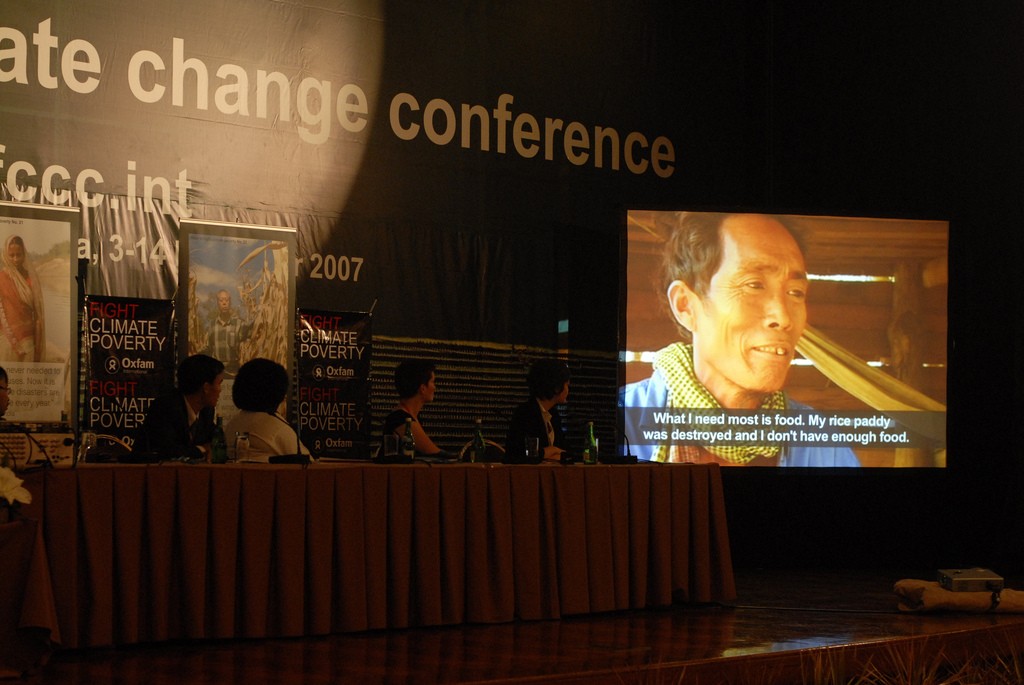
សន្និសីទអង្គការសហប្រជាជាតិស្តីពីបម្រែបម្រួលអាកាសធាតុ នៅទីក្រុងបាលី។ រូបភាព ដោយ អង្គការ អុកស្វាម អន្តរជាតិ, ៤ ធ្នូ ២០០៧។ ក្រោមអាជ្ញាប័ណ្ណ CC BY-NC-ND 2.0
បម្រែបម្រួលអាកាសធាតុជាបញ្ហាកំពុងតែកើតមាន។ក្នុងតំបន់អាស៊ីអាគ្នេយ៍ ប្រទេសកម្ពុជាជាប្រទេសមួយក្នុងចំណោមប្រទេសដែលទទួលរងផលប៉ះពាល់ខ្លាំងជាងគេពីបម្រែបម្រួលអាកាសធាតុនិងមានការត្រៀមខ្លួនតិចតួច។ ក្នុងនាមជាប្រទេសកំពុងអភិវឌ្ឍន៍ ប្រជាជនភាគច្រើនរបស់ប្រទេសនេះពឹងផ្អែកទៅលើវិស័យកសិកម្មសម្រាប់ស្បៀងអាហារនិងការប្រកបរបរចិញ្ចឹមជីវិត។អ្នកជំនាញបានព្រមានថា បម្រែបម្រួលអាកាសធាតុអាចបង្កឱ្យមានគ្រោះរាំងស្ងួត ឬគ្រោះទឹកជំនន់ច្រើនជាងមុនសម្រាប់កម្ពុជា។
កសិកម្មស្រូវរបស់ប្រទេសកម្ពុជាពឹងផ្អែកទៅលើទឹកភ្លៀងជាចម្បង។ការពឹងផ្អែកនេះ កំពុងធ្វើឱ្យវិស័យកសិកម្មងាយទទួលរងគ្រោះពីផលប៉ះពាល់នៃបម្រែបម្រួលអាកាសធាតុ។
រដ្ឋាភិបាល បានធ្វើការស្តាឡើងវិញនូវហេដ្ឋារចនាសម្ព័ន្ធជាប្រព័ន្ធធារាសាស្ត្រដែលមានស្រាប់ និងសាងសង់ថ្មីបន្ថែមទៀត។ ក្នុងឆ្នាំ២០១៣ រដ្ឋមន្ត្រីធនធានទឹក លោក លឹម គានហោ បានឱ្យដឹងថា ប្រព័ន្ធធារាសាស្ត្របានគ្របដណ្តប់លើផ្ទៃដីសរុប ចំនួន ១.៤ លានហិកតា ដែលស្មើនឹង ប្រមាណជា ៦៣ % នៃផ្ទៃដីដាំដុះទូទាំងប្រទេស។1
យ៉ាងនេះក្តី នៅខែកញ្ញា ឆ្នាំ២០១៥ សារព័ត៌មានភ្នំពេញប៉ុស្តិ៍ បានរាយការណ៍ថា យោងតាមទិន្នន័យក្រសួងកសិកម្ម ផ្ទៃដីចំនួន១៨៥,៤៥១ ហិកតា នៅខេត្តចំនួន១៣ ជួបប្រទះនឹងស្ថានភាពគ្រោះរាំងស្ងួត ដែលជាកំណើនពីតួរលេខចំនួន១១៦, ១២៩ហិកតា ដោយសារតែកង្វះទឹកភ្លៀងក្នុងរដូវវស្សាកាលពីឆ្នាំ២០១៤។2
សម្រាប់ប្រទេសកម្ពុជា ជម្រើសក្នុងការបន្ស៊ាំខ្លួនទៅនឹងបម្រែបម្រួលអាកាស ធាតុមានតិចតួច។ កម្ពុជាបានស្នើរសុំជំនួយផ្នែកហិរញ្ញវត្ថុទៅលើការបន្សាំខ្លួន និងការកាត់បន្ថយការប្រែប្រួលអាកាសធាតុ ពីប្រទេសអភិវឌ្ឍន៍ ដែលជាប្រទេសទទួលខុសត្រូវក្នុងការចូលរួមចំណែកបង្កឱ្យមានបម្រែបម្រួលអាកាសធាតុ។ ឧទាហរណ៍ កម្មវិធីបន្សាំខ្លួនទៅនឹងបម្រែបម្រួលអាកាសធាតុនៅសហគមន៍ ក្នុងប្រទេសកម្ពុជា (CCBAP)ដែលឧបត្ថម្ភដោយប្រទេសស៊ុយអែតនិងជំនួយរដ្ឋាភិបាលអូស្ត្រាលី(AusAID) ក្នុងគោលបំណងពង្រឹងសមត្ថភាពសហគមន៍ទៅលើការកាត់បន្ថយការប្រែប្រួលអាកាសធាតុនិងការបន្សាំខ្លួនទៅនឹងបម្រែបម្រួលអាកាសធាតុ។ កម្មវិធីនេះទទួលបានជំនួយជាទឹកប្រាក់ចំនួន២.៨ លានដុល្លារ ទៅលើគម្រោងចំនួន៤៦ សម្រាប់ភូមិចំនួន ៣៨០ ឃុំចំនួន ១០៧ ស្រុកចំនួន៥៦ និងខេត្តចំនួន២១។3
យុទ្ធសាស្ត្រនៃការបន្សាំខ្លួនទៅនឹងបម្រែបម្រួលអាកាសធាតុ
ឯកសារយុទ្ធសាស្រ្ត ការប្រាស្រ័យទាក់ទងថ្នាក់ជាតិនៃប្រទេសកម្ពុជា ត្រូវបានបោះពុម្ពផ្សាយ https://camclimate.org.kh/en/documents-and-media/library/category/137-national-report.html?download=878:cambodia-s-inc-under-unfccc_aug-2002 ក្នុងឆ្នាំ២០០២ និងក្រោយមកទៀត ត្រូវបានបោះពុម្ពផ្សាយ ជាលើកទី២ ក្នុងឆ្នាំ២០១៥។ ប្រទេសកម្ពុជា បានកំណត់យកតម្រូវការឱ្យមានការបន្សាំខ្លួនទៅនឹងបម្រែបម្រួលអាកាសធាតុ សម្រាប់វិស័យកសិកម្ម និងព្រៃឈើ ដែលជាវិស័យអាទិភាព។4
- វិស័យកសិកម្ម៖ សំណូមពរនៃការបន្សាំខ្លួនទៅនឹងបម្រែបម្រួលអាកាសធាតុ រួមមានការបង្កើតប្រភេទដំណាំកសិផលដែលផ្តល់ទិន្នផលខ្ពស់ កែលម្អលើការគ្រប់គ្រងដំណាំកសិផល ការបង្កើតប្រព័ន្ធប្រកាសអាសន្នសម្រាប់ហេតុការណ៍អាកាសធាតុអាក្រក់ខ្លាំង និងកែលម្អប្រព័ន្ធធារាសាស្ត្រ។5
- វិស័យព្រៃឈើ៖ បង្កើនការដាំដុះព្រៃឈើ អភិរក្សតំបន់ការពារ និងធ្វើឱ្យការគ្រប់គ្រងព្រៃឈើកាន់តែប្រសើរឡើង។6
គោលនយោបាយបន្សាំខ្លួនទៅនឹងបម្រែបម្រួលអាកាសធាតុ
ការបន្សាំខ្លួនទៅនឹងបម្រែបម្រួលអាកាសធាតុទាមទារឱ្យមានក្របខណ្ឌច្បាប់សម្រាប់ដោះស្រាយជាមួយនឹងផលប៉ះពាល់នៃបម្រែបម្រួលអាកាសធាតុ។7
គោលនយោបាយអន្តរវិស័យពាក់ពន្ធ័ទៅនឹងបម្រែបម្រួលអាកាសធាតុនៅក្នុងប្រទេសកម្ពុជា រាប់បញ្ចូលទាំងផែនការយុទ្ធសាស្ត្រអភិវឌ្ឍជាតិ(NSDP) ឆ្នាំ២០១៤-២០១៨។ គោលនយោបាយនេះ បានចាត់ទុកបញ្ហាបម្រែបម្រួលអាកាសធាតុជាផ្នែកចម្បងនៃគោលនយោបាយ និងធ្វើការកំណត់សកម្មភាពសំខាន់ៗមួយចំនួន៖ ការកសាងសមត្ថភាព ការបញ្ជ្រាប កិច្ចការលើយុទ្ធសាស្ត្រជាតិ ការបង្កើតមូលនិធិបម្រែបម្រួលអាកាសធាតុ ការអនុវត្តនិងការធ្វើបច្ចុប្បន្នភាពលើកម្មវិធីសកម្មភាពបន្សាំថ្នាក់ជាតិ ការបង្កើតយន្តការអភិវឌ្ឍស្អាត (CDM) ការអប់រំអំពីបញ្ហាអាកាសធាតុ ការពង្រឹងការគ្រប់គ្រងទិន្នន័យផ្ទះកញ្ចក់ និងការចែករំលែកធនធាន។
ការបញ្ជ្រាបគោលនយោបាយបម្រែបម្រួលអាកាសធាតុក៏ត្រូវបានលើកឡើងក្នុងកម្មវិធីជាតិសម្រាប់ការអភិវឌ្ឍតាមបែបប្រជាធិបតេយ្យនៅថ្នាក់ក្រោមជាតិ ឆ្នាំ២០១០-២០១៩(NP-SNDD) សេចក្តីព្រាងយុទ្ធសាស្ត្រជាតិស្តីអំពីការគាំពារសង្គម និងយុទ្ធសាស្ត្រជាតិស្តីពីការត្រៀមបង្ការគ្រោះមហន្តរាយផងដែរ។8
ផែនទីជាតិស្តីពីកំណើនបៃតងឆ្នាំ២០០៩ បានបង្ហាញអំពីមាគ៌ារយៈពេលខ្លី រយៈពេលមធ្យម និងរយៈពេលវែង សម្រាប់ការអនុវត្តកំណើនបៃតងក្នុងប្រទេសកម្ពុជា។ ផែនទីនេះ ជួយបង្កើនភាពធន់ និងកាត់បន្ថយភាពងាយរងគ្រោះរបស់កម្ពុជាក្នុងការប្រឈមទៅនឹងបម្រែបម្រួលអាកាសធាតុ។9
ផែនការសកម្មភាពជាតិសម្រាប់គម្រោងបន្សាំខ្លួនទៅនឹងបម្រែបម្រួលអាកាសធាតុ(NAPA) មានគោលបំណងផ្តល់ក្របខណ្ឌសម្រាប់ចង្អុលបង្ហាញពីការសម្របសម្រួលនិងការអនុវត្តកិច្ចផ្តួចផ្តើមនៃការបន្សាំខ្លួន តាមរយៈវិធីសាស្ត្រចូលរួមចំណែក និងបង្កើតចំណុចរួមជាមួយកម្មវិធីបរិស្ថាននិងកម្មវិធីអភិវឌ្ឍន៍ពាក់ព័ន្ធ។10
ផែនការយុទ្ធសាស្ត្របម្រែបម្រួលអាកាសធាតុឆ្នាំ២០១៤-២០២៣ បង្កើតឱ្យមានជាផែនការថ្នាក់ជាតិមួយសម្រាប់គាំទ្រការអភិវឌ្ឍប្រកបដោយចីរភាពនៅកម្ពុជា ក៏ដូចជាចូលរួមក្នុងការកាត់បន្ថយភាពងាយរងគ្រោះទៅនឹងបម្រែបម្រួលអាកាសធាតុ។11
កិច្ចផ្តួចផ្តើមថ្នាក់តំបន់
កិច្ចផ្តួចផ្តើមបម្រែបម្រួលអាកាសធាតុនិងការបន្សុាំ នៃគណៈកម្មការទន្លេមេគង្គ(CCAI) គឺជាកិច្ចខិតខំប្រឹងប្រែងរួមមួយក្នុងចំណោមប្រទេសជាសមាជិកនៃគណៈកម្មការទន្លេមេគង្គ រួមមានប្រទេសកម្ពុជា ឡាវ ថៃនិងវៀតណាមដើម្បីបង្ហាញនិងចែករំលែកយុទ្ធសាស្ត្របន្សាំខ្លួនទៅនឹងបម្រែបម្រួលអាកាសធាតុ។ដោយផ្តោតទៅលើវិធីសាស្ត្រអាងទន្លេទូលាយ កិច្ចផ្តួចផ្តើមនេះ ធានាថា ការបន្សាំខ្លួនទៅនឹងបម្រែបម្រួលអាកាសធាតុ ត្រូវបានធ្វើឱ្យចុះសម្រុងគ្នាជាមួយយុទ្ធសាស្ត្រ និងផែនការមានប្រសិទ្ធភាព នៅកម្រិតផ្សេងគ្នា និងត្រូវបានយកមកអនុវត្ត នៅតាមទីតាំងជាអាទិភាពជាច្រើនទូទាំងអាងទន្លេ។12
ដោយយកតាមវិធីសាស្ត្រវាយតម្លៃមានស្រាប់ កម្មវិធីបរិស្ថានស្នូលមហាអនុតំបន់ទន្លេមេគង្គ(CEP)បានបង្កើតក្របខណ្ឌចូលរួមមួយសម្រាប់វាយតម្លៃពីភាពងាយរងគ្រោះនិងកំណត់ជម្រើសនៃការបន្សុាំខ្លួននៅតាមសហគមន៍ជនបទនៃមហាអនុតំបន់ទន្លេមេគង្គ។ កម្មវិធីនេះ មានគោលបំណងបង្ហាញពីរបៀបដែល ក្របខណ្ឌតាមដំណាក់កាល អាចជួយបកស្រាយព័ត៌មានបែបវិទ្យាសាស្ត្រដែលមានស្រាប់ ទៅជាជម្រើសសម្រាប់ការបន្សុាំខ្លួន ក៏ដូចជាផ្សព្វផ្សាយអំពីការដាក់បញ្ចូលបញ្ហាបម្រែបម្រួលអាកាសធាតុ ទៅក្នុងគម្រោងនៅថ្នាក់សហគមន៍។13
ធ្វើបច្ចុប្បន្នភាពចុងក្រោយ៖ ២៩ កុម្ភៈ ២០១៦
ទាក់ទងនឹងការបន្សាំខ្លួនទៅនឹងបម្រែបម្រួលអាកាសធាតុ
ឯកសារយោង
- 1. ហោ គីមសាយ. “អ្នកជំនាញ៖ កសិកម្មត្រូវការប្រាក់កម្ចីនិងប្រព័ន្ធធារាសាស្ត្របន្ថែមទៀត.” ភ្នំពេញប៉ុស្តិ៍ ២០ ឧសភា ២០១៣. ចូលអាន ១ កុម្ភៈ ២០១៦. http://www.phnompenhpost.com/business/agriculture-needs-more-loans-irrigation-systems-experts-say
- 2. សែន ដេវីត និង Ethan Harfenist. “គ្រោះរាំងស្ងួតបានប៉ះពាល់ដល់ខេត្ត ចំនួន១៣.” ភ្នំពេញប៉ុស្តិ៍ ០១ កញ្ញា ឆ្នាំ២០១៥. ចូលអាន ១ កុម្ភៈ២០១៦.http://www.phnompenhpost.com/national/drought-batters-13-provinces
- 3. អង្គការសហប្រជាជាតិសម្រាប់កម្មវិធីអភិវឌ្ឍន៍ ប្រចាំប្រទេសកម្ពុជា.ករណីសិក្សាលើកម្មវិធីបន្សាំខ្លួនទៅនឹងបម្រែបម្រួលអាកាសធាតុនៅសហគមន៍ ក្នុងប្រទេសកម្ពុជា៖ឧទាហរណ៍ចំនួនពីរមកពីកម្មវិធីបន្សាំខ្លួនទៅនឹងបម្រែបម្រួលអាកាសធាតុតាមសហគមន៍ រងផលប៉ះពាល់នៅតាមទីជនបទក្នុងប្រទេសកម្ពុជា(CCBAP). ចូលអាន ៤ កុម្ភៈ ២០១៦. http://www.kh.undp.org/content/dam/cambodia/docs/EnvEnergy/Final_Case_Study_Report_CCBAP_Eng.pdf.
- 4. ក្រសួងបរិស្ថាន. ការប្រាស្រ័យទាក់ទងថ្នាក់ជាតិនៃប្រទេសកម្ពុជា លើទីពីរ. ចូលអាន ៤ កុម្ភៈ ២០១៦.https://camclimate.org.kh/en/documents-and-media/library/category/137-national-report.html?download=724:cambodia%E2%80%99s-second-national-communication_nov-2015
- 5. ដូចឯកសារយោងខាងលើ.
- 6. ដូចឯកសារយោងខាងលើ.
- 7. ណាង ភិរុណ.កិច្ចការស្រាវជ្រាវ.ការបន្សាំខ្លួនទៅនឹងបម្រែបម្រួលអាកាសធាតុ និងជីវភាពរស់នៅក្នុងកំណើនសេដ្ឋកិច្ចរួមបញ្ចូល៖ ការពិនិត្យលើផលប៉ះពាល់ ពីបម្រែបម្រួលអាកាសធាតុនិងសមត្ថភាពបន្សាំខ្លួននៅកម្ពុជា. វិទ្យាស្ថានបណ្តុះបណ្តាលនិងស្រាវជ្រាវដើម្បីអភវិឌ្ឍកម្ពុជា (CDRI):២០១៣.ចូលអាន ៤ ឧសភា ២០១៥.https://cdri.org.kh/wp-content/uploads/wp82e.pdf
- 8. “ស្ថានភាពបម្រែបម្រួលអាកាសធាតុនៅកម្ពុជា.” Energypedia. ចូលអាន ១០ កញ្ញា ២០១៤.https://energypedia.info/wiki/Climate_Change_Situation_Cambodia
- 9. ផែនទីជាតិស្តីពីកំណើនបៃតងឆ្នាំ២០០៩. http://www.greengrowth.org/sites/default/files/pictures/Final%20Draft%20Roadmap,%20Feb26-2010.pdf.
- 10. ផែនការសកម្មភាពជាតិសម្រាប់គម្រោងបន្សាំខ្លួនទៅនឹងបម្រែបម្រួលអាកាសធាតុ(NAPA). http://unfccc.int/resource/docs/napa/khm01.pdf
- 11. ផែនការយុទ្ធសាស្ត្របម្រែបម្រួលអាកាសធាតុឆ្នាំ២០១៤-២០២៣.http://www.kh.undp.org/content/dam/cambodia/docs/EnvEnergy/CCCAProjects/Cambodia%20climate%20change%20strategic%20plan%202014-2023.pdf
- 12. “គណៈកម្មការទន្លេមេគង្គ.” កិច្ចផ្តួចផ្តើមបម្រែបម្រួលអាកាសធាតុនិងការបន្សុាំ.ចូលអាន ១០ កញ្ញា ២០១៤.http://www.mrcmekong.org/about-mrc/programmes/climate-change-and-adaptation-initiative/.
- 13. បម្រែបម្រួលអាកាសធាតុនិង សហគមន៍ជនបទនៅមហាអនុតំបន់ទន្លេមេគង្គ៖ក្រមខណ្ឌសម្រាប់ការវាយតម្លៃលើភាពងាយរងគ្រោះនិងជម្រើសនៃការបន្សាំខ្លួន.ធនាគារអភិវឌ្ឍអាស៊ី, ២០១៣.http://www.adb.org/sites/default/files/publication/42089/climate-change-rural-communities-gms.pdf

